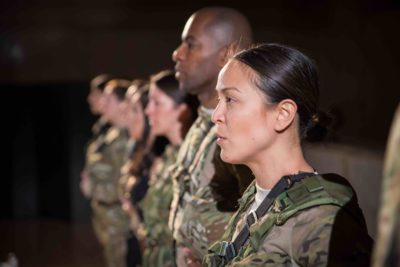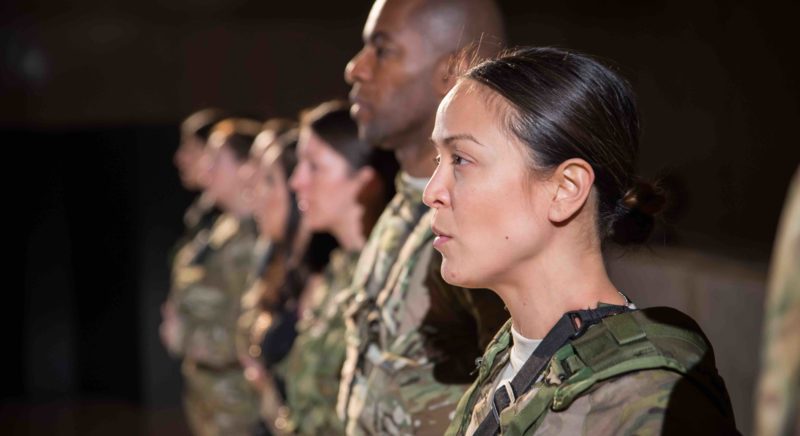INTERVIEW: ‘Bullet Catchers’ follows first mixed gender infantry unit in the Army

The new play Bullet Catchers is set in the not-too-distant future and surrounds the wartime experiences of the first mixed gender infantry unit in the United States Army. The production is the brainchild of Maggie Moore and Julia Sears, who are billed as co-conceivers but not playwrights. That’s because the entire company, including Moore and Sears, took part in the dialogue and story creation.
The company features many military veterans, actors who probably know the slang term “bullet catcher,” which is used by Army personnel to describe infantry.
Bullet Catchers continues its run through Saturday, Aug. 5 at Judson Memorial Church in New York City. Recently, Hollywood Soapbox exchanged emails with Moore about the new play. Questions and answers have been slightly edited for style.
What inspired you two to conceive this play?
I had been working on lifting the combat exclusion policy for women in the armed forces since 2014 at the Truman National Security Project on a campaign called No Exceptions. Through my time there, I brought the issue of women in combat to Julia as one of my closest friends. When I moved to New York, we saw the first three females were getting ready to graduate from Army Ranger school in August of 2015, and both Julia and I were thrilled. In discussing the news, Julia immediately thought of bringing these stories to the stage through a residency she received from Opera House Arts in Stonington, [Maine].
What was the collaboration like during the writing process with the actors?
As a devised piece, the entire script was written by all of the actors as well as Julia and myself. The first step was to have everyone interview a veteran or current service member to learn their stories and hear their experiences. I think everyone was a bit nervous at first to call themselves a writer, but as the process continued, everyone found their creative voice [as] playwrights and brought their incredible skills to the table. It was always a very open and collaborative room.
Did you have to conduct a lot of research on the topic? How many interviews went into the project?
In total, we interviewed around 35 veterans and service members. The people we spoke with were both men and women from each of the branches (Army, Air Force, Navy and Marines), ranging from Vietnam to post-9/11 conflicts. All of the actors conducted at least one interview, with a few taking on more. We also had the opportunity to visit Fort Dix in New Jersey. Unfortunately I was unable to visit, so Julia can absolutely provide more detail about that amazing trip!
From Sears: We went to a virtual gun range, did Humvee [High Mobility Multipurpose Wheeled Vehicle] roll over training, witnessed a weapons retention class, had a chance to try on Kevlar vests and look into an MRAP [Mine-Resistant Ambush Protected] and Humvee, and attend live evacuation simulation. We also spoke with about 15 male and female Army and Airmen while we toured the base. The trip was organized by Staff Sgt. Caitlin Jones.
What do you hope audiences learn from the drama?
I want our audience to walk away with a better understanding of the diversity of the military experience. In many portrayals of war and combat in pop culture, you often see veterans cast in two lights: that of the values-drive[n] patriot or the down-trodden PTSD [Post-Traumatic Stress Disorder] sufferer. In reality, service members have a rich diversity of experiences that deserve to be shown. I also hope to show that topics that are headlines in the news have real human impact. When we talk about the military, it can be easy to forget the person behind it all.
Do you believe this piece of theatrical art is also activist in nature?
I think this piece is less about activism and more about allowing audience members to experience the news issue first hand. We are currently grappling with tough questions about service, strength and sacrifice. We are showing the audience imperfect people doing their jobs well and allowing them to decide where they land on the issue of women in combat.
Why is it important for you to engage with active military personnel and veterans throughout the process?
It was important for us to engage with veterans and service members on this project because we wanted to tell this story with them, not for them. A goal for this show has been to bring veteran and civilian artists together, and New York City is an incredible place to do this in. There are thousands of veteran artists in New York, and who better to bring a unique story to the stage than them.
By John Soltes / Publisher / John@HollywoodSoapbox.com
Bullet Catchers, co-conceived by Maggie Moore and Julia Sears, continues through Saturday, Aug. 5 at Judson Memorial Church in New York City. Click here for more information and tickets.

